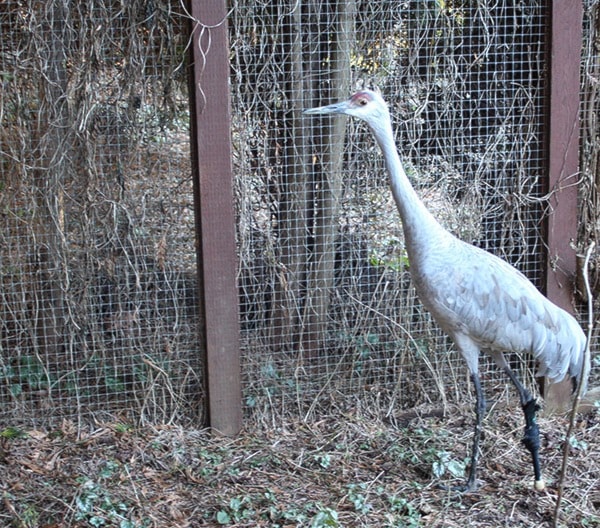Bunker walks gracefully and confidently around his pen, one foot planted firmly in front of the other, his head held high.
It's only on closer inspection that one would question how he is able to maneuver so effortlessly.
The rare sandhill crane's right limb is supported by a long black plastic piece – a prosthetic device that replaces the portion of his leg that had to be amputated last year after he was wounded on a golf course.
Bunker has been recovering for almost a year, and it was only in December that a more permanent solution was found for his disability.
Now, Abbotsford veterinarian Dr. Ken Macquisten and Elizabeth Melnick of Elizabeth's Wildlife Center (in photo below) anticipate being able to eventually release the bird to his natural habitat.
"He is using the leg very well and seems to be comfortable. It is giving us some reason to be a tiny bit more optimistic that he might be the first bird to ever be returned to the wild with a prosthesis," Macquisten said.
Bunker's leg was shattered by a flying golf ball on the Country Meadows Golf Course in Richmond last March.
He was captured by a wildlife biologist, who then called Macquisten, whom he had worked with many times in the past, and was brought to the Whatcom Road Veterinary Hospital for assessment.
The bird's leg was beyond repair, and Macquisten had to amputate it. He then crafted a makeshift prosthesis using a wood dowel and some door insulation for cushioning so that the crane would be able to stand.
 Bunker was taken to Elizabeth's Widlife Center, also in Abbotsford, and then later to a conservation centre to convalesce.
Bunker was taken to Elizabeth's Widlife Center, also in Abbotsford, and then later to a conservation centre to convalesce.
The first artificial leg was replaced with a more sturdy one – this time, using thick metal wire – but Macquisten faced the challenge of making or finding a more permanent prosthesis.
Further challenges were created when Bunker developed an infection known as "bumblefoot" from putting most of his weight on his remaining foot.
He required two surgeries, and has remained for observation in a backyard aviary at Macquisten's home.
Once media reports of Bunker's situation were published online, Macquisten was contacted by
OrthoPets, a company in Denver, Colorado that produces prosthetic devices for animals, mainly dogs.
Co-owner Dr. Patrice Mich said, although the company has worked with birds before, they had never before made a prosthesis for a sandhill crane.
"I was optimistic that we had a chance of success and wanted to give Bunker that opportunity," she said, adding that, without such support, Bunker might have faced euthanasia.
The company requested that Macquisten construct a cast of Bunker's stump and amputated limb and send it to them to be used as a mold.
A few months later, Macquisten received back the sturdy plastic prosthesis, which came with a neoprene "sock" to be inserted inside.
He was eager to try out the device on Bunker, and snapped it into place around Bunker's stump without difficulty. The bird adapted immediately.
"He put weight on it right away, shook his feathers and then went to eat," Macquisten said.
That was on Dec. 22, and Bunker, who Macquisten estimates is about two years old, has had no difficulties with the prosthesis. While he hobbled around on the other devices, he now walks without a limp.
The plan is to release Bunker back into the wild, preferably near the golf course where he was found and pending approval from the Canadian Wildlife Service, but Macquisten said that will likely not be for at least another year.
Bunker must first completely heal from his bumblefoot and must have a long period without complications.
If he is able to be released, the hope is to equip him with a tracking device so his prosthesis can be monitored on regular basis.
Sandhill cranes live into their 20s, and Macquisten hopes that Bunker will have many years ahead.
Mich said she is pleased with how well Bunker has adapted.
"Each case we take on is its own challenge because each patient is unique in terms of species, injury, environment, treatment and so on. Bunker's case is further motivation to continue this work."
